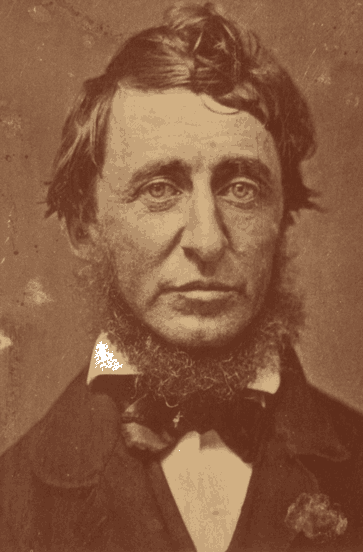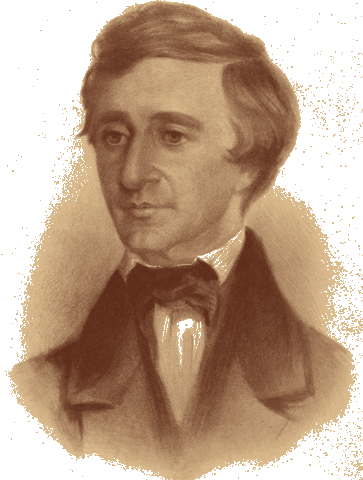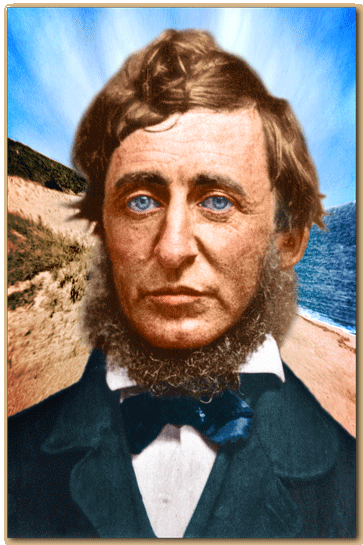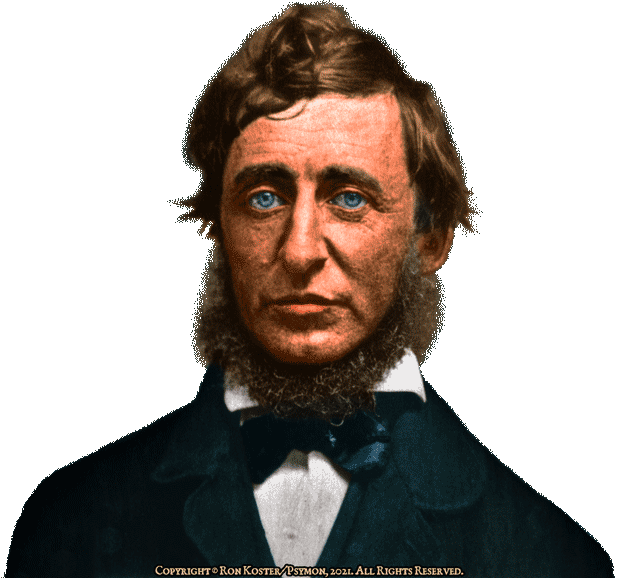
The Wellfleet Penman:
Thoreau in Colour
by Ron Koster

The Maxham Daguerreotype
Other Portraits of Thoreau
Colouring the Maxham Daguerreotype
Background, Time & Place
Thoreau in Colour

The 1856 daguerreotype taken by Benjamin D. Maxham.

The Maxham Daguerreotype
In the aim of creating a “colour photograph” of Henry David Thoreau — which you can view at the end of this chapter — I decided to start with the daguerreotype taken by Benjamin D. Maxham at Worcester, Massachusetts on June 13th, 1856, as shown above. In fact, three of these portraits were made at that time; however, they are all virtually identical except for minor, negligible differences. These daguerreotypes were done initially at the request of a Rochester, Michigan admirer named Calvin H. Greene, who had sent Thoreau $5.00 so that he could have one made for himself, and also asking that copies of Thoreau’s two books be sent to his brother in California. Thoreau had earlier responded to Greene’s request for a portrait by writing to him that he would “[. . .] have the best of me in my books [. . .] I am not worth seeing personally — the stuttering, blundering, clod-hopper that I am,” but eventually the portraits would be done and Greene was sent one along with a letter which said, in part, “While in Worcester this week I obtained the accompanying daguerreotype — which my friends think is pretty good — though better looking than I.” In addition to the portrait and letter, Thoreau also included $1.70 in change (the two other daguerreotypes made at that time were given to Thoreau’s Worcester friends H.G.O. Blake and Theo. Brown).
It will be noted in comparing these two aforementioned images that the final “colourized” version of Thoreau’s portrait has been flipped over from the original daguerreotype — this is intentional, because it was an anomaly of daguerreotypes that the image created by that method was, in fact, a negative one. That this early portrait is indeed reversed can be confirmed quite easily by looking at the part in Thoreau’s hair as it was in the other authenticated portraits made of him in his lifetime.

Other Portraits of Thoreau

The 1854 crayon drawing by Samuel Worcester Rowse.
Above, we have the only portrait of Thoreau as he looked as a younger man, a crayon drawing done by Samuel Worcester Rowse (whose drawings would ultimately make him famous all over the world) during the summer of 1854 while he was boarding at the Thoreau home. Another boarder in their home was Eben J. Loomis, who wrote about how the Rowse portrait came about:
I was very much interested in watching him [Rowse] while he was watching the expression of Henry’s face. For two or three weeks he did not put a pencil to paper; but one morning at breakfast, he suddenly jumped up from the table, asked to be excused and disappeared for the rest of the day. The next morning he brought down the crayon, almost exactly in its present form, scarcely another touch was put upon it.
It is for me, on the whole, the most satisfactory likeness, for it represents Henry just as he was in that summer, so memorable to me, memorable for my intimacy with Henry.
For fans of Thoreau this portrait has always been particularly special, for it is a rather youthful depiction of Henry just as we might well imagine that he probably looked while he lived at Walden Pond (from 1845 to 1847) — in fact, the summer that Rowse created this drawing is the same summer that Walden was first published.

The 1861 ambrotype taken by E.S. Dunshee.
Here, above, is the only other portrait ever made of Thoreau in his lifetime, an ambrotype which was taken by E.S. Dunshee on August 19th, 1861, while Thoreau was visiting his friend Daniel Ricketson in New Bedford. We can see in this portrait that Thoreau didn’t look quite as robust as he did five years earlier when the Maxham daguerreotype was taken. Unfortunately, he had already been suffering for some time from tuberculosis, and Ricketson wrote that during this particular visit “he has a bad cough and expectorates a good deal, is emaciated considerably, his spirits, however, appear as good as usual, his appetite good.” Thoreau had written to Ricketson himself several days earlier (on August 15th) that “My ordinary pursuits, both indoor and out, have been for the most part omitted, or seriously interrupted — walking, boating, scribbling, &c. Indeed I have been sick so long that I have almost forgotten what it is to be well.” Thoreau would never really fully recover, and about nine months after this ambrotype was taken, at 9:00AM on May 6th, 1862, he passed away.

Colouring the Maxham Daguerreotype
Apart from just generally cleaning up the original daguerreotype image — i.e. removing various scratches, etc. — it was also hoped that the final coloured version would be as “true-to-life” as possible, choosing colours that would depict Thoreau as he really did look. With his still being fairly healthy at this time (and looking so in Maxham’s portrait), and with him spending a great deal of time outdoors, it’s fairly safe to say that he must have had a reasonably good suntan — in fact, if one looks closely at the artwork, I’ve even given him the slightest bit of a pinkish sunburn on his forehead, cheeks and nose.
As for choosing the colour for his hair, beard and eyes, these naturally required a bit of research, but luckily we do have some very good descriptions of how he looked (and, indeed, not only of his appearance but his general demeanor as well).
Franklin B. Sanborn, Thoreau’s friend and later his biographer, first met him in 1855 (the year before Maxham’s daguerreotype was taken) and noted at that time in his diary that Thoreau was. . .
[. . .] a little under size, with a huge Emersonian nose, bluish-gray eyes, brown hair, and a ruddy weather-beaten face, which reminds one of some shrewd and honest animal’s — some retired philosophical woodchuck or magnanimous fox. He dresses very plainly, wears his collar turned over like Mr. Emerson and often an old dress-coat, broad in the skirts, and by no means a fit. He walks about in a brisk, rustic air, and never seems tired.
From this we know that Thoreau’s eye colour was “bluish-gray” and that his hair was brown. The former is corroborated by Thoreau’s friend Ellery Channing:
His face, once seen, could not be forgotten. The features were quite marked: the nose aquiline or very Roman, like one of the portraits of Cæsar (more like a beak, as was said); large overhanging brows above the deepest set blue eyes that could be seen, in certain lights, and in others gray, — eyes expressive of all shades of feeling, but never weak or near-sighted; the forehead not unusually broad or high, full of concentrated energy and purpose; the mouth with prominent lips, pursed up with meaning and thought when silent, and giving out when open with the most varied and unusual instructive sayings.
And so “bluish-gray” eyes most certainly would seem to be correct, but exactly what shade of brown hair did he have? Edward Emerson — the son of Ralph Waldo Emerson — provides us with a slightly more accurate description:
His type was Northern, — strong features, light brown hair, an open-air complexion with suggestion of a seafaring race; the mouth pleasant and flexible when he spoke, aquiline nose, deep-set but very wide-open eyes of clear blue grey, sincere, but capable of a twinkle, and again of austerity, but not of softness.
Thus, Thoreau’s hair was not just simply “brown” but more specifically “light brown,” and Emerson’s mention of Thoreau’s “open-air complexion” also confirms the assumption that he must have had a healthy tan. As for the colouring of the coat, shirt and bowtie, well, anyone’s guess is as good as mine (although from Sanborn’s description of him something relatively “plain” seemed appropriate) and so I simply chose colours which weren’t too garish or flashy, but which at the same time complemented the other colours used in this piece.

Background, Time & Place
In addition to my wish to “colourize” a portrait of Thoreau, I also thought it would be nice to put him in some setting that was a little more meaningful — naturally, Walden Pond, the Maine Woods, or Cape Cod come to mind as obvious choices. Unfortunately, however, none of these places figured in his somewhat limited travels during the year 1856, when Maxham’s portrait was taken. Only Cape Cod figures prominently during this period in Thoreau’s life, with his having made trips there both in 1855 (with Ellery Channing) and his final trip there, alone, in 1857.
Thus, Cape Cod seemed like a fitting locale to put him in. Various sources mention that Thoreau had only started growing his beard (in this style, which was known as “Galway whiskers”) some months before the photo was taken in 1856, and so it is likely that this is how he probably still appeared on his last visit there in 1857.
As for choosing a picture of Cape Cod to work with, it seemed only natural to use one of the photos done by Herbert W. Gleason, who had originally been hired by Houghton Mifflin to take photographs for their 20-volume edition of The Writings of Henry David Thoreau (published in 1906). One of the more memorable parts of Thoreau’s Cape Cod is his account of “The Wellfleet Oysterman” — and thus not only was Gleason’s photo of that area chosen for the background scene for this piece, but hence also arose the title that I chose to give it (referring, of course, to Thoreau himself as the “penman,” being the prolific writer that he was). Obviously some artistic liberties have been taken with that Gleason photograph; however, the colours chosen for the sand, etc. were based on various photos of that area which can be found all over the internet.

Photo of beach bluffs at Cape Cod, by Herbert W. Gleason.

Thoreau in Colour
The completed artwork depicting Thoreau at Cape Cod, in colour, is shown below.
Please note that this artwork is available at much higher resolution and available for free download on the Digital Art Wallpapers page of this website, in both standard and widescreen formats. :-)

Digital artwork by Ron Koster/Psymon.
❦
Questions? Comments? Bug report?
☞ Contact Me! ☜
❦
Acknowledgements
All original text, graphics and web deisign of this entire site
are copyright © Ron Koster/Psymon, 2021 (except as otherwise noted)
and may not be reproduced or distributed in any manner
without explicit permission.
See: A Note on Copyright.
All Rights Reserved.
|





